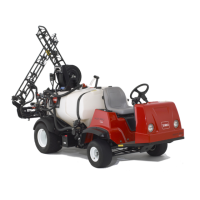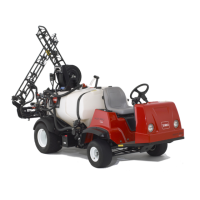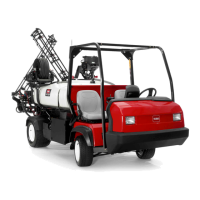42
FIG. 28
1. Tie Rod (one nut on each end)
FIG. 29
EMERGENCY/PARKING BRAKE
MAINTENANCE:
WARNING
Brake failure can cause loss of control
and result in serious injury or death.
Test Brake function and correct before
operation.
Check adjustment of the Emergency/Parking
Brake every 200 hours.
1. Loosen set screw securing the Adjustment
Knob to Emergency/Parking Brake Lever. Rotate
the Adjustment Knob on the end of the Lever.
Turn it clockwise to increase brake force,
counterclockwise to decrease brake force. (See
FIG. 30)
Front Wheel
Center-to-center
Distance
Front
of Tire
Rear
of Tire
plus zero minus 1/8"
2. Rotate knob until a force of 35-45 lbs is
required to actuate lever.
3. Tighten set screw after adjustment has been
attained.
INSPECT BRAKES:
Visually inspect brakes for worn brake shoes after
every 600 hours of operation. The brake fluid
reservoir is shipped from the factory filled with
DOT 3 brake fluid. Check level before engine
is first started and every 8 hours or daily thereafter.
To Check Brake Fluid/Master Cylinder, see Before
Operating, page 18.
FIG. 30
1. Brake Lever 3. Set Screw
2. Adjustment Knob
1881-1200
2
3
1
INSPECT TIRES:
Check tire condition at least every 200 hours of
operation. Operating accidents such as hitting
curbs can damage a tire or rim and also disrupt
wheel alignment, so inspect tire condition after
an accident. To check Tire Pressure, see Before
Operating, page 19.
FRONT WHEEL TOE-IN:
After every 400 operating hours or annually,
check front wheel toe-in.
1. While the vehicle is unloaded measure
center-to-center distance (axle height) at front and
rear of steering tires. Front measurement must
be equal to the rear measurement plus zero
minus 1/8 inch. (FIG. 28)
2. To adjust, loosen jam nuts at both ends of
the Tie Rod (FIG. 29).
3. Rotate Tie Rod to move front of tire inward or
outward.
4. Tighten Tie Rod jam nuts when adjustment
is correct.
MAINTENANCE
1
1882
NOTE: Steering angle should be same in both
directions.

